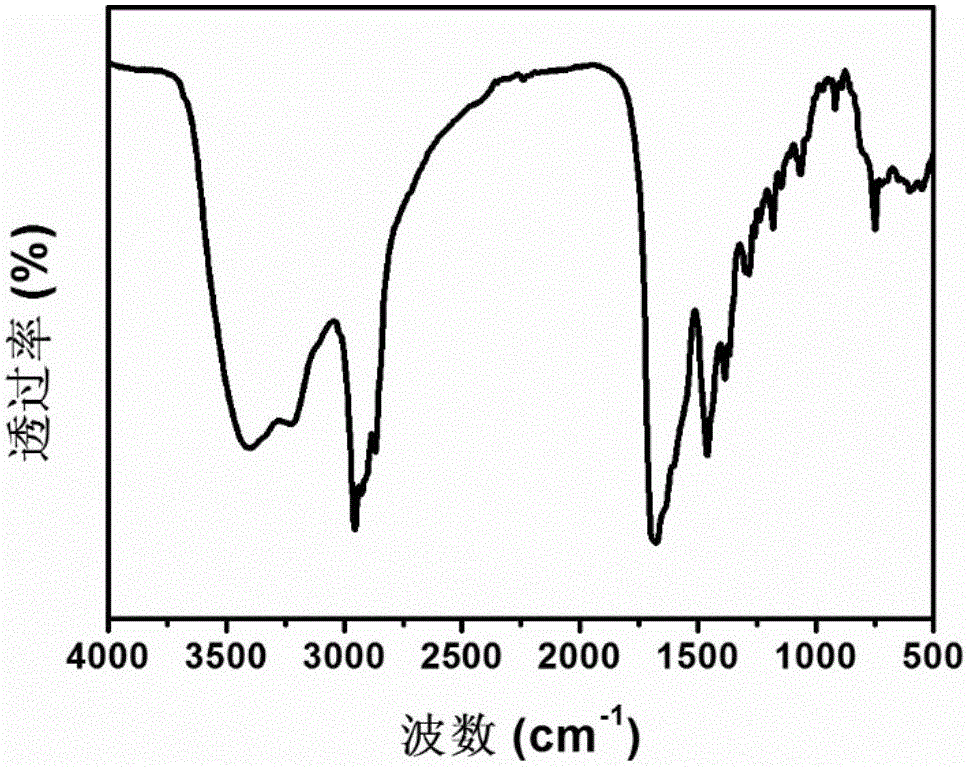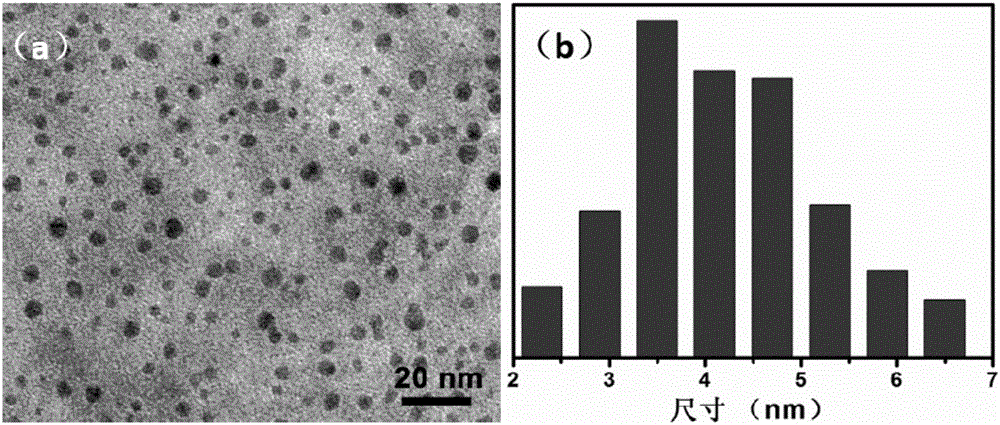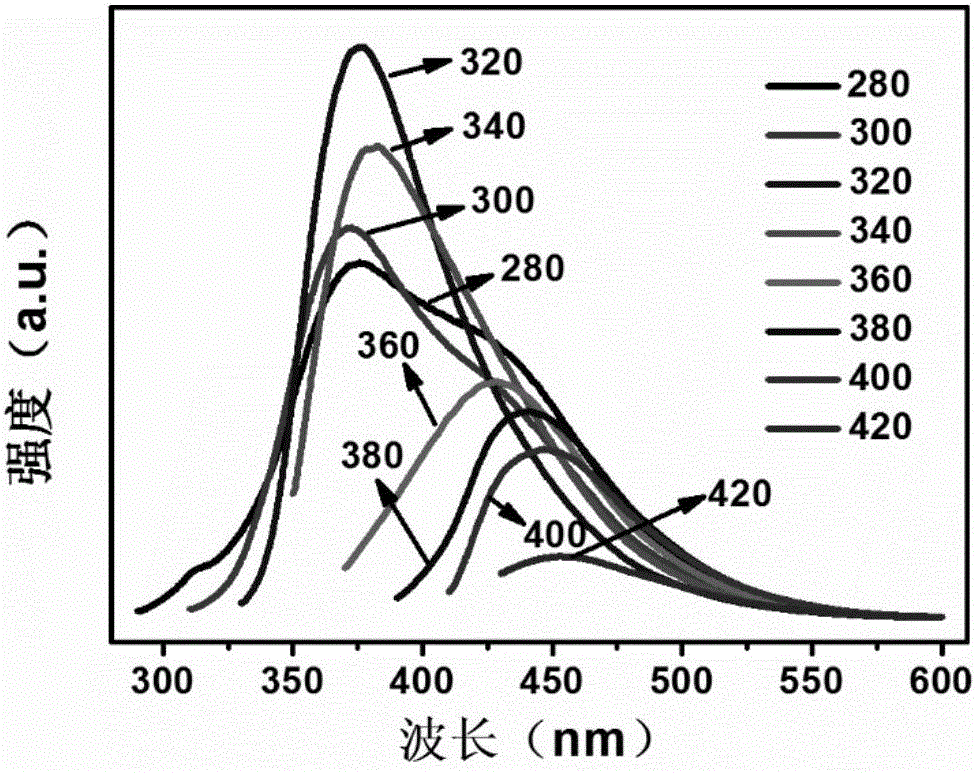Amphiphilic carbon dot with room-temperature phosphorescent property and synthesizing method and application thereof
An amphiphilic carbon, room temperature phosphorescence technology, applied in fluorescence/phosphorescence, chemical instruments and methods, luminescent materials, etc., can solve the problems of easy self-assembly, cumbersome preparation methods, limited application of carbon dots, etc., and achieves low cost and preparation. Simple and easy method
- Summary
- Abstract
- Description
- Claims
- Application Information
AI Technical Summary
Problems solved by technology
Method used
Image
Examples
Embodiment 1
[0036] This embodiment provides a method for synthesizing amphiphilic carbon dots with room temperature phosphorescent properties, which includes the following steps:
[0037] (1) Weigh 50 mg of oil-soluble carbon dots and ultrasonically disperse them into 50 g of deionized water to obtain a mixed solution. The ultrasonic power is 500 W, and the ultrasonic time is 10 min;
[0038] (2) placing the mixed solution obtained in (1) in a polytetrafluoroethylene high-pressure sealed tank, and heating and reacting at 180° C. for 3 hours to obtain an initial solution;
[0039] (3) Centrifuge the initial solution obtained in (2) at a speed of 10,000 rpm for 20 minutes to remove the black precipitate, take the upper layer of light yellow clear liquid, and filter it through a filter head of 0.22 microns to obtain pure amphiphilic carbon point water solution;
[0040] (4) The carbon quantum dot aqueous solution obtained in (3) was freeze-dried for 12 to 96 hours to obtain an amphiphilic car...
Embodiment 2
[0047] This embodiment provides a method for synthesizing amphiphilic carbon dots with room temperature phosphorescent properties, which includes the following steps:
[0048] (1) Weigh 50 mg of oil-soluble carbon dots and ultrasonically disperse them into 50 g of deionized water to obtain a mixed solution. The ultrasonic power is 500 W, and the ultrasonic time is 20 min;
[0049] (2) placing the mixed solution obtained in (1) in a polytetrafluoroethylene high-pressure sealed tank, and heating and reacting at 240° C. for 5 hours to obtain an initial solution;
[0050] (3) Centrifuge the initial solution obtained in (2) at a speed of 10,000 rpm for 20 minutes to remove the black precipitate, take the upper layer of light yellow clear liquid, and filter it through a filter head of 0.22 microns to obtain pure amphiphilic carbon point water solution;
[0051] (4) The carbon quantum dot aqueous solution obtained in (3) was freeze-dried for 12 to 96 hours to obtain an amphiphilic c...
Embodiment 3
[0053] This embodiment provides a method for synthesizing amphiphilic carbon dots with room temperature phosphorescent properties, which includes the following steps:
[0054] (1) Weigh 50 mg of oil-soluble carbon dots and ultrasonically disperse them into 20 g of deionized water to obtain a mixed solution. The ultrasonic power is 500 W, and the ultrasonic time is 30 min;
[0055] (2) placing the mixed solution obtained in (1) in a polytetrafluoroethylene high-pressure sealed tank, and heating and reacting at 180° C. for 5 hours to obtain an initial solution;
[0056] (3) Centrifuge the initial solution obtained in (2) at a speed of 10,000 rpm for 20 minutes to remove the black precipitate, take the upper layer of light yellow clear liquid, and filter it through a filter head of 0.22 microns to obtain pure amphiphilic carbon point water solution;
[0057] (4) The carbon quantum dot aqueous solution obtained in (3) was freeze-dried for 12 to 96 hours to obtain an amphiphilic c...
PUM
| Property | Measurement | Unit |
|---|---|---|
| particle diameter | aaaaa | aaaaa |
| particle size | aaaaa | aaaaa |
Abstract
Description
Claims
Application Information
 Login to View More
Login to View More - R&D
- Intellectual Property
- Life Sciences
- Materials
- Tech Scout
- Unparalleled Data Quality
- Higher Quality Content
- 60% Fewer Hallucinations
Browse by: Latest US Patents, China's latest patents, Technical Efficacy Thesaurus, Application Domain, Technology Topic, Popular Technical Reports.
© 2025 PatSnap. All rights reserved.Legal|Privacy policy|Modern Slavery Act Transparency Statement|Sitemap|About US| Contact US: help@patsnap.com



